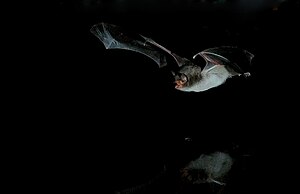Long-footed bat
| Long-footed bat | ||||||||||||
|---|---|---|---|---|---|---|---|---|---|---|---|---|

Long-footed bat ( Myotis capaccinii ) |
||||||||||||
| Systematics | ||||||||||||
|
||||||||||||
| Scientific name | ||||||||||||
| Myotis capaccinii | ||||||||||||
| Bonaparte , 1837 |
The long-footed bat ( Myotis capaccinii , also known as the large-footed bat ) is a bat species from the mouse- eared species , which was first described by Bonaparte in 1837 . The scientific species name honors the Italian Cardinal Francesco Capaccini .
features
The long-footed bat is a medium-sized bat with a head-trunk length of about 5 centimeters and a wingspan of about 25 centimeters. The upper side is lighter than other mouse-eared species and colored smoky gray. The ventral side is light gray and not sharply demarcated from the top. The snout is red-brown, ears and membranes are brown-gray. The feet are unusually large and covered with long bristles. The arm skin extends to the heel. The lower legs are very hairy. The tail fly skin is covered with dark fluff. The nostrils protrude quite a bit.
Similar types:
distribution
The long-footed bat is quite common in the Mediterranean. In the past, the range reached as far as the Alps, but these populations are now probably extinct. Further occurrences can be found in North Africa and east to Iran and Uzbekistan.
Way of life
Long-footed bats prefer to stay in areas rich in bushes near water. In both summer and winter, the animals sleep in caves, tunnels and cellars. The animals are very sociable, and winter quarters with over 3000 animals have been found. Long-footed bats also form colonies with other bat species such as mouse-eared bats or long-winged bats .
Long-footed bats are crepuscular. They like to hunt for insects over water, which they eat in flight. The flight is similar to that of the water bat . The long-footed bat is the species of bat in Europe that is best adapted to catch insects from the surface of the water. In individual populations, the animals also hunt fish that live in the area of the water surface. They specialize in particular in the Eastern mosquito fish ( Gambusia holbrooki ), which come from the United States and are newly introduced in southern Europe , which when hunting for insects and insect larvae pierce the surface of the water with their upper lip and are thus visible to the bats.
Status and protection
The long-footed bat is listed by the European Union in Annexes II and IV of the Habitats Directive and is therefore a species of community interest that must be strictly protected, and special protected areas must be designated for their preservation.
supporting documents
- ↑ Ostaizka Aizpurua, Antton Alberdi, Joxerra Aihartza, Inazio Garin: Fishing Technique of Long-Fingered Bats What Developed from a Primary Reaction to Disappearing target stimuli. PLOS One, December 14, 2016. doi : 10.1371 / journal.pone.0167164
literature
- Friederike Spitzelberger The mammal fauna of Austria ; Green series of the Federal Ministry for Agriculture, Forestry, Environment and Water Management - Volume 13, Graz 2001, ISBN 3-85333-063-0
Web links
- Myotis capaccinii inthe IUCN 2013 Red List of Threatened Species . Posted by: Hutson, AM, Spitzenberger, F., Aulagnier, S., Juste, J., Karataş, A., Palmeirim, J. & Paunović, M., 2008. Accessed January 21, 2014.

